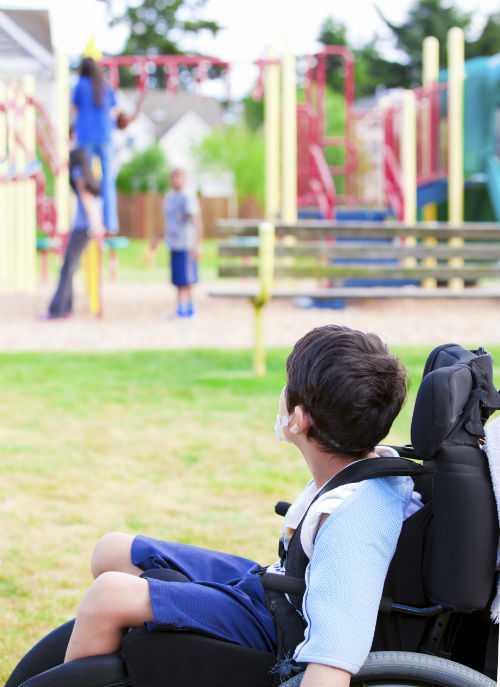Key Findings: Development of a community health inclusion index: an evaluation tool for improving inclusion of people with disabilities in community health initiatives.
A study about the Community Health Inclusion Index (CHII), a new evaluation tool for improving inclusion of people with disabilities in community health initiatives, was recently published in the BMC Public Health journal.
The information collected through the CHII can be used by public health professionals and community programs to understand the needs in their communities and develop new initiatives for improving healthy, active living among people with disabilities.
The study was co-authored by the Institute on Disability and Human Development at the University of Illinois at Chicago; the University of Alabama at Birmingham/Lakeshore Foundation Research Collaborative; and the Centers for Disease Control and Prevention (CDC).
What is Known, and What Does the Study Add?
As many as 57.6 million people or 18% of the U.S. population have disabilities.[1] [2] People with disabilities are a diverse group of individuals, who have limitations in:
- Mobility (such as difficulty or inability to walk),
- Cognition (such as difficulty in thinking, learning, understanding, reasoning, or making decisions), and/or
- Sensory function (such as vision or hearing difficulties).
As a group, people with disabilities are more likely to be physically inactive[3] [4] [5] have greater health problems[6] [7] [8] [9] and experience more barriers to taking part in physical activity and maintaining good nutrition compared to people without disabilities[10] [11] [12].

Visit the National Center on Health, Physical Activity, and Disability (NCHPAD) to download the Community Health Inclusion Index (CHII) and make sure that people with disabilities enjoy equal access to community health resources and opportunities.
Main Findings
The CHII can be used:
- To learn how current Healthy Communities programs, designed to promote healthy living opportunities, impact the health of people with disabilities.
- Alongside other tools that measure physical activity and healthy eating at the community level to assess gaps and needs. Some of these other tools are not designed to fully take into account factors that impact people with disabilities, including the growing number of baby boomers who are aging into disability.
- To adjust, enhance and/or develop strategies for adults and children with disabilities that will modify the environment to reduce or remove barriers to physical activity and healthy food choices.
About This Study
The development and testing of the CHII involved four steps:
- A literature review of studies that examined barriers to healthy, active living, as well as factors that make it easier to achieve these outcomes.
- Focus groups among individuals with disabilities and professionals working with them in diverse communities around the United States.
- An expert panel to narrow down a final set of critical items that can influence the inclusion of people with disabilities in community health programs.
- Field testing of the tool in 164 sites across 15 communities in five states to determine if the survey could be successfully used in unique communities and settings.
What Can Be Done?
Decision-makers, public health officials, and disability organizations can use the CHII to:
- Achieve a better understanding of the challenges people with disabilities face in participating in physically activities and in accessing healthy foods within their communities.
- Develop and implement strategies to improve the availability of and access to physical activity and nutritional programs, which may in turn bring about healthier lifestyles for people with disabilities.
CDC’s Activities
CDC’s Disability and Health Branch monitors the health of people with and without disabilities, and supports the inclusion of people with disabilities in public health programs that prevent disease and promote healthy behaviors. In addition, CDC works to eliminate barriers to health care and improve access to routine preventive services.
CDC supports 18 state-based disability and health programs and four National Public Health Practice and Resource Centers, which promote healthy lifestyles and work to improve quality of life for people with disabilities. The primary goals of the state programs are to:
- Increase health promotion opportunities for people with disabilities.
- Improve access to healthcare services for people with disabilities.
- Improve emergency preparedness for people with disabilities.
CDC also maintains the Disability and Health Data System (DHDS), an online interactive tool that provides instant access to state-level, disability-specific health data. Users can customize the disability and health data they view, making it easy to identify health differences between adults with and without disabilities.
Additional Information
Find out more about CDC’s Disability and Health Branch at https://www.cdc.gov/ncbddd/disabilityandhealth/index.html
Find out more about the National Center on Health, Physical Activity, and Disability (NCHPAD) at http://www.nchpad.org/
References
- Centers for Disease Control and Prevention (CDC). CDC grand rounds: public health practices to include persons with disabilities. MMWR Morb Mort Wkly Rep. 2013;62:697-701.
- Brault MW. Americans with disabilities: 2010. In: Current Population Reports. Washington, DC: U.S. Census Bureau; 2012. p. 70-131.
- Altman, B, Bernstein A. Disability and health in the United States, 2001-2005. Hyattsville: National Center for Health Statistics; 2008.
- Centers for Disease Control and Prevention (CDC). Physical activity among adults with a disability – United States, 2005. MMWR Morb Mort Wkly Rep. 2007;56:1021-4.
- Carroll DD, Courtney-Long EA, Stevens AC, Sloan ML, Lullo C, Visser SN, Fox MH, Armour BS, Campbell VA, Brown DR, Dorn JM. Vital signs: disability and physical activity – United States, 2009-2012. MMWR Morb Mort Wkly Rep. 2014 May; 63:407-13.
- Wilber N, Mitra M, Walker DK, Allen DA, Meyers AR, Tupper P. Disability as a public health issue: findings and reflections from the Massachusetts survey of secondary conditions. Milbank Q. 2002;80:393-421.
- Rasch E, Magder L, Hochberg MC, Magaziner J, Altman BM. Health of community-dwelling adults with mobility limitations in the United States: incidence of secondary health conditions. Part II. Arch Phys Med Rehabil. 2008;89:219-30.
- Rimmer JH, Chen M-D, Hsieh K. A conceptual model for identifying, preventing, and treating secondary conditions in people with disabilities. Phys Ther. 2011;91:1728-38.
- Dixon-Ibarra A, Horner-Johnson W. Disability status as an antecedent to chronic conditions: National Health Interview Survey, 2006-2012. Prev Chronic Dis. 2014;11:1-8.
- Rimmer J, Rubin S, Braddock D. Barriers to exercise in African-American women with physical disabilities. Arch Phys Med Rehabil. 2000;81:182-8.
- Stuifbergen A, Becker H, Sands D. Barriers to health promotion for individuals with disabilities. Fam Community Health. 1990;13:11-22.
- Mulligan HF, Hale LA, Whitehead L, Baxter GD. Barriers to physical activity for people with long-term neurological conditions: a review study. Adapt Phys Activ Q. 2012;29(3):243-65.
Eisenberg Y, Rimmer JH, Mehta T, Fox MH. Development of a community health inclusion index: an evaluation tool for improving inclusion of people with disabilities in community health initiatives. BMC Public Health. 2015 Oct 13; 15(1):1050.
- Page last reviewed: March 28, 2016
- Page last updated: March 28, 2016
- Content source:


 ShareCompartir
ShareCompartir
